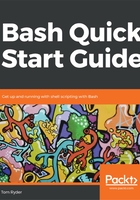
To get the most out of this book
You should have access to a computer with Bash 4.0 or higher installed or available, and be able to type commands into it via a TTY, terminal emulator, Telnet, or SSH connection (for example, using PuTTY). This book does give some guidance in the first chapter on how to install Bash on your system if it's not already there, or if the installed version is too old (as may be the case on macOS X). You will need either administrative-level (root) access to the computer to install Bash yourself, or a cooperative systems administrator to help you.
If you are not sure which operating system to use, we recommend the Ubuntu distribution of GNU/Linux, available from https://www.ubuntu.com/. The LTS (Long Term Support) version will do fine. Ubuntu is open source, free to download, thoroughly documented, and relatively easy to install. You can run this operating system in a virtual machine using a program or hypervisor such as VMware or VirtualBox—it does not have to be installed directly on your computer's hardware.
At the time of writing, Windows 10 has a new Bash subsystem available and in active development, the Windows Subsystem for Linux. You may find that most of the material in this book is relevant and usable on such a system, but the book does not specifically support this, and we highly recommend installing a full GNU/Linux or BSD system for your learning and experiments instead.